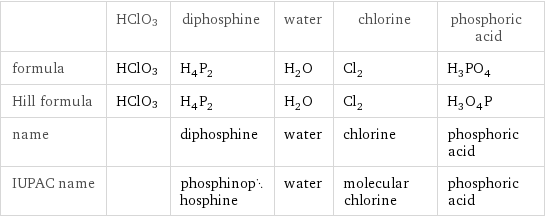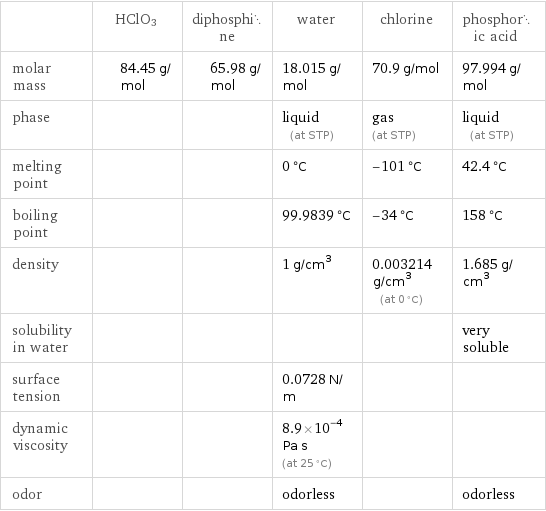Input interpretation

HClO3 + H_4P_2 diphosphine ⟶ H_2O water + Cl_2 chlorine + H_3PO_4 phosphoric acid
Balanced equation

Balance the chemical equation algebraically: HClO3 + H_4P_2 ⟶ H_2O + Cl_2 + H_3PO_4 Add stoichiometric coefficients, c_i, to the reactants and products: c_1 HClO3 + c_2 H_4P_2 ⟶ c_3 H_2O + c_4 Cl_2 + c_5 H_3PO_4 Set the number of atoms in the reactants equal to the number of atoms in the products for H, Cl, O and P: H: | c_1 + 4 c_2 = 2 c_3 + 3 c_5 Cl: | c_1 = 2 c_4 O: | 3 c_1 = c_3 + 4 c_5 P: | 2 c_2 = c_5 Since the coefficients are relative quantities and underdetermined, choose a coefficient to set arbitrarily. To keep the coefficients small, the arbitrary value is ordinarily one. For instance, set c_3 = 1 and solve the system of equations for the remaining coefficients: c_1 = 7 c_2 = 5/2 c_3 = 1 c_4 = 7/2 c_5 = 5 Multiply by the least common denominator, 2, to eliminate fractional coefficients: c_1 = 14 c_2 = 5 c_3 = 2 c_4 = 7 c_5 = 10 Substitute the coefficients into the chemical reaction to obtain the balanced equation: Answer: | | 14 HClO3 + 5 H_4P_2 ⟶ 2 H_2O + 7 Cl_2 + 10 H_3PO_4
Structures

HClO3 + ⟶ + +
Names

HClO3 + diphosphine ⟶ water + chlorine + phosphoric acid
Equilibrium constant
![Construct the equilibrium constant, K, expression for: HClO3 + H_4P_2 ⟶ H_2O + Cl_2 + H_3PO_4 Plan: • Balance the chemical equation. • Determine the stoichiometric numbers. • Assemble the activity expression for each chemical species. • Use the activity expressions to build the equilibrium constant expression. Write the balanced chemical equation: 14 HClO3 + 5 H_4P_2 ⟶ 2 H_2O + 7 Cl_2 + 10 H_3PO_4 Assign stoichiometric numbers, ν_i, using the stoichiometric coefficients, c_i, from the balanced chemical equation in the following manner: ν_i = -c_i for reactants and ν_i = c_i for products: chemical species | c_i | ν_i HClO3 | 14 | -14 H_4P_2 | 5 | -5 H_2O | 2 | 2 Cl_2 | 7 | 7 H_3PO_4 | 10 | 10 Assemble the activity expressions accounting for the state of matter and ν_i: chemical species | c_i | ν_i | activity expression HClO3 | 14 | -14 | ([HClO3])^(-14) H_4P_2 | 5 | -5 | ([H4P2])^(-5) H_2O | 2 | 2 | ([H2O])^2 Cl_2 | 7 | 7 | ([Cl2])^7 H_3PO_4 | 10 | 10 | ([H3PO4])^10 The equilibrium constant symbol in the concentration basis is: K_c Mulitply the activity expressions to arrive at the K_c expression: Answer: | | K_c = ([HClO3])^(-14) ([H4P2])^(-5) ([H2O])^2 ([Cl2])^7 ([H3PO4])^10 = (([H2O])^2 ([Cl2])^7 ([H3PO4])^10)/(([HClO3])^14 ([H4P2])^5)](../image_source/e2519b49003b61a7531f97048a281769.png)
Construct the equilibrium constant, K, expression for: HClO3 + H_4P_2 ⟶ H_2O + Cl_2 + H_3PO_4 Plan: • Balance the chemical equation. • Determine the stoichiometric numbers. • Assemble the activity expression for each chemical species. • Use the activity expressions to build the equilibrium constant expression. Write the balanced chemical equation: 14 HClO3 + 5 H_4P_2 ⟶ 2 H_2O + 7 Cl_2 + 10 H_3PO_4 Assign stoichiometric numbers, ν_i, using the stoichiometric coefficients, c_i, from the balanced chemical equation in the following manner: ν_i = -c_i for reactants and ν_i = c_i for products: chemical species | c_i | ν_i HClO3 | 14 | -14 H_4P_2 | 5 | -5 H_2O | 2 | 2 Cl_2 | 7 | 7 H_3PO_4 | 10 | 10 Assemble the activity expressions accounting for the state of matter and ν_i: chemical species | c_i | ν_i | activity expression HClO3 | 14 | -14 | ([HClO3])^(-14) H_4P_2 | 5 | -5 | ([H4P2])^(-5) H_2O | 2 | 2 | ([H2O])^2 Cl_2 | 7 | 7 | ([Cl2])^7 H_3PO_4 | 10 | 10 | ([H3PO4])^10 The equilibrium constant symbol in the concentration basis is: K_c Mulitply the activity expressions to arrive at the K_c expression: Answer: | | K_c = ([HClO3])^(-14) ([H4P2])^(-5) ([H2O])^2 ([Cl2])^7 ([H3PO4])^10 = (([H2O])^2 ([Cl2])^7 ([H3PO4])^10)/(([HClO3])^14 ([H4P2])^5)
Rate of reaction
![Construct the rate of reaction expression for: HClO3 + H_4P_2 ⟶ H_2O + Cl_2 + H_3PO_4 Plan: • Balance the chemical equation. • Determine the stoichiometric numbers. • Assemble the rate term for each chemical species. • Write the rate of reaction expression. Write the balanced chemical equation: 14 HClO3 + 5 H_4P_2 ⟶ 2 H_2O + 7 Cl_2 + 10 H_3PO_4 Assign stoichiometric numbers, ν_i, using the stoichiometric coefficients, c_i, from the balanced chemical equation in the following manner: ν_i = -c_i for reactants and ν_i = c_i for products: chemical species | c_i | ν_i HClO3 | 14 | -14 H_4P_2 | 5 | -5 H_2O | 2 | 2 Cl_2 | 7 | 7 H_3PO_4 | 10 | 10 The rate term for each chemical species, B_i, is 1/ν_i(Δ[B_i])/(Δt) where [B_i] is the amount concentration and t is time: chemical species | c_i | ν_i | rate term HClO3 | 14 | -14 | -1/14 (Δ[HClO3])/(Δt) H_4P_2 | 5 | -5 | -1/5 (Δ[H4P2])/(Δt) H_2O | 2 | 2 | 1/2 (Δ[H2O])/(Δt) Cl_2 | 7 | 7 | 1/7 (Δ[Cl2])/(Δt) H_3PO_4 | 10 | 10 | 1/10 (Δ[H3PO4])/(Δt) (for infinitesimal rate of change, replace Δ with d) Set the rate terms equal to each other to arrive at the rate expression: Answer: | | rate = -1/14 (Δ[HClO3])/(Δt) = -1/5 (Δ[H4P2])/(Δt) = 1/2 (Δ[H2O])/(Δt) = 1/7 (Δ[Cl2])/(Δt) = 1/10 (Δ[H3PO4])/(Δt) (assuming constant volume and no accumulation of intermediates or side products)](../image_source/1d9d4d19e9d06707d5cf181b721fbccc.png)
Construct the rate of reaction expression for: HClO3 + H_4P_2 ⟶ H_2O + Cl_2 + H_3PO_4 Plan: • Balance the chemical equation. • Determine the stoichiometric numbers. • Assemble the rate term for each chemical species. • Write the rate of reaction expression. Write the balanced chemical equation: 14 HClO3 + 5 H_4P_2 ⟶ 2 H_2O + 7 Cl_2 + 10 H_3PO_4 Assign stoichiometric numbers, ν_i, using the stoichiometric coefficients, c_i, from the balanced chemical equation in the following manner: ν_i = -c_i for reactants and ν_i = c_i for products: chemical species | c_i | ν_i HClO3 | 14 | -14 H_4P_2 | 5 | -5 H_2O | 2 | 2 Cl_2 | 7 | 7 H_3PO_4 | 10 | 10 The rate term for each chemical species, B_i, is 1/ν_i(Δ[B_i])/(Δt) where [B_i] is the amount concentration and t is time: chemical species | c_i | ν_i | rate term HClO3 | 14 | -14 | -1/14 (Δ[HClO3])/(Δt) H_4P_2 | 5 | -5 | -1/5 (Δ[H4P2])/(Δt) H_2O | 2 | 2 | 1/2 (Δ[H2O])/(Δt) Cl_2 | 7 | 7 | 1/7 (Δ[Cl2])/(Δt) H_3PO_4 | 10 | 10 | 1/10 (Δ[H3PO4])/(Δt) (for infinitesimal rate of change, replace Δ with d) Set the rate terms equal to each other to arrive at the rate expression: Answer: | | rate = -1/14 (Δ[HClO3])/(Δt) = -1/5 (Δ[H4P2])/(Δt) = 1/2 (Δ[H2O])/(Δt) = 1/7 (Δ[Cl2])/(Δt) = 1/10 (Δ[H3PO4])/(Δt) (assuming constant volume and no accumulation of intermediates or side products)
Chemical names and formulas

| HClO3 | diphosphine | water | chlorine | phosphoric acid formula | HClO3 | H_4P_2 | H_2O | Cl_2 | H_3PO_4 Hill formula | HClO3 | H_4P_2 | H_2O | Cl_2 | H_3O_4P name | | diphosphine | water | chlorine | phosphoric acid IUPAC name | | phosphinophosphine | water | molecular chlorine | phosphoric acid
Substance properties

| HClO3 | diphosphine | water | chlorine | phosphoric acid molar mass | 84.45 g/mol | 65.98 g/mol | 18.015 g/mol | 70.9 g/mol | 97.994 g/mol phase | | | liquid (at STP) | gas (at STP) | liquid (at STP) melting point | | | 0 °C | -101 °C | 42.4 °C boiling point | | | 99.9839 °C | -34 °C | 158 °C density | | | 1 g/cm^3 | 0.003214 g/cm^3 (at 0 °C) | 1.685 g/cm^3 solubility in water | | | | | very soluble surface tension | | | 0.0728 N/m | | dynamic viscosity | | | 8.9×10^-4 Pa s (at 25 °C) | | odor | | | odorless | | odorless
Units
